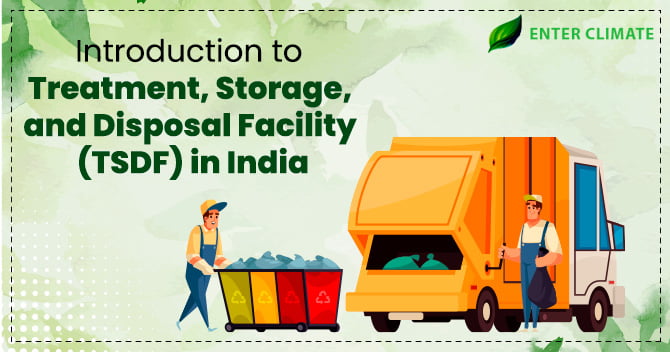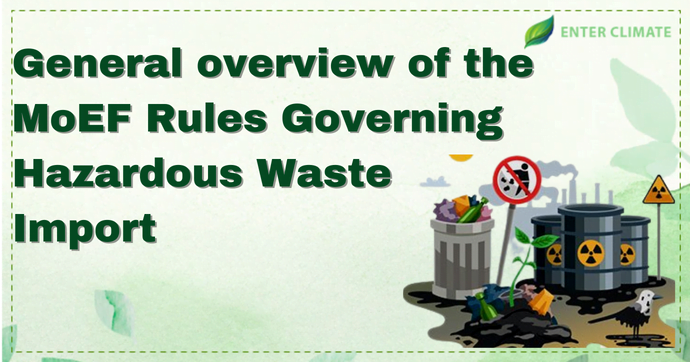Introduction to Treatment, Storage, and Disposal Facility (TSDF) in India
 30 Jul, 2022
30 Jul, 2022 
Hazardous and Other Wastes (Management & Transboundary Movement) Rules, 2016definesaTreatment, Storage, and Disposal Facility (TSDF) as a dedicated facility for storing, treating, and disposing hazardous waste. Despite the massive amount of hazardous waste generated, India has an acute shortage of TSDFs. Around 88 hazardous waste incinerators and 220 recycling facilities exist in the country, along with two engineered landfills. There are 18 Integrated TSDFs (with both SLF & Incinerator), 18 TSDFs with secured landfills and 11 TSDFs with standalone incinerators in the country presently. Many small and large-scale industrial units are disposing off their waste in open spaces and adjacent to water sources either due to a lack of knowledge or due to the lack of Treatment, Storage, and Disposal facility nearby, resulting in environmental pollution and risking public health. In this article, we will focus on the essential characteristics of a TSDF, mandatory safety compliance and the responsibilities of the TSDF owner(operator). We have dealt with the Hazardous Waste Management Rules, 2016 in detail in another article, i.e.Overview of Hazardous Waste Management Rules in India.
Sources of Hazardous Waste
Although hazardous characteristics of the waste have been defined in the HWM Rules of 2016[1], here, we have provided a list of waste sources that can be used to decide if the waste generated by your facility is hazardous.
- Waste Oil/Used Oil/ Skimmed oil /oily sludge, Oil contaminated earth.
- Primary Effluent Treatment Plant Sludge (ETP), Sludge from water treatment plants, solar plants, Sulphur Sludge.
- Discarded containers of Chemicals and Hazardous substances.
- Expired/off specific/discarded chemicals and products.
- Ash from waste incineration, dust from processing, etc.
- Sludge generated during the processing of waste
- Contaminated filters/Centrifuge bags, resin residues
- Spent Activated Carbon, Spent Catalysts.
- Dust/Particulate from exhaust gas/flue gas treatment
- Miscellaneous wastes like used cotton, gloves, and gumboots.
Role of Treatment, Storage, and Disposal Facility in Waste Management: An Overview
Understanding the role of TSDF in hazardous waste management is critical in deciding whether any industry requires such services for its waste management. Any facility where the process of generation, handling, collection, reception, treatment, storage, reuse, recycling, recovery, pre-processing, co-processing, utilisation and disposal of hazardous and other wastes must be aware of the role of TSDF. So, read on if you plan on starting a Treatment, Storage, and Disposal Facility or indulging with a TSDF for your waste management!
“T” or Treatment and Stabilisation of waste
Treatment or stabilisation of waste means converting hazardous wastes (non-aqueous liquids, semi-solids or reactive solids) into less leachable solids. This step changes the hazardous nature of the waste to a less hazardous category. Treatment is done to stabilise the hazardous waste so that it can be deposited directly into the secured landfills according to the state’s concentration limits and the criteria set by SPCBs. Treatment can also be done to alter the character or composition of hazardous wastes. Some treatment processes enable waste to be recovered and reused in manufacturing, while other treatment processes reduce the contaminant level of organic/inorganic components and some dramatically reduce the amount of hazardous waste through incineration or oxidation.
Steps involved in the treatment
The treated wastes before disposal in the landfill are assessed in the Treatment, Storage, and Disposal Facility for compatibility with other wastes and the liner system. Treatment of HW intends to cover several steps, including
- Receiving waste for its storage in an appropriate/designated place
- Adding reagents as per the pre-estimated quantities. Typical reagents include lime, fly ash, bentonite (clay), cement, sawdust, etc., in combination with sodium silicate solution.
- Mixing and curing to immobilise and fixate the contaminants within a cementing structure to reduce the mobility or leaching character of the hazardous waste constituents
- Solidification means the thermal treatment of the waste by the addition of solidification and adsorption agents to remove moisture and organics so that they do not readily de-water.
- ̇Analysis of the stabilised sample through Toxicity Characteristics Leaching Procedure or TCLP[2].
- ̇Transfer of stabilised material to landfill
‘S’ or Storage of Waste
CPCBhas provided specific guidelines for storage units that must be ensured by all authorised Treatment, Storage and Disposal Facilities in the country. Collecting hazardous waste is a potentially hazardous practice; therefore, the HWM Rules of 2016lay down specific responsibilities for treatment, Storage, and Disposal Facility and infrastructural guidelines for building storage facilities which are as follows.
- The TSDF operator must solely store the hazardous waste in lined containers to accumulate quantity.
- Each container must be clearly marked to identify its contents and the date(s) of accumulation at the facility, and such information for each consignment must be recorded and maintained in the facility.
- Proper guidelines should be followed for the drums to be used for storage of incinerable wastes, spillage or leakage control measures to be adopted in the event of any leakages or spillages, record keeping and maintenance, requirement of fire detection, protection and safety measures. Safety audits must also be carried out yearly by the Treatment, Storage, and Disposal Facility operator and a reputed expert agency at least once in two years.
- If the waste management is not in accordance with the authorisation issued by the SPCB/PCC, the TSDF operator shall reject the waste for further treatment and disposal.
- The existing CPCB guidelines for storing incinerable hazardous wastes and the revised guidelines for storing and handling incinerable hazardous wastes. Guidelines for storage of incinerable hazardous waste by the operators of Common Treatment, Storage, and Disposal Facility and Captive Hazardous Waste Incinerators must be followed for compliance.
Guidelines for storage facilities
The structural guidelines issued by CPCB must be adopted in establishing the storage facility. In designing these cells to be used for storage, the following points must be taken into consideration.
- ̇The storage area should have a proper containment system, meaning it should have an adequate collection to collect and remove any leak, spill, or precipitation
- The treatment, storage, and Disposal Facility must be designed in such a way that the floor level of the storage area is at least 150 millimetres above the maximum flood level.
- ̇Open storage is not permissible in any case. The designated hazardous waste storage area must be in proper enclosures.
- ̇Proper stacking of drums with wooden frames must be practised.
- ̇Incase of spills/leaks, cotton must be used for cleaning instead of water
- Signboards showing precautionary measures to be taken in normal and emergency situations shall be displayed at appropriate locations.
- ̇Manual operations within the storage area should be avoided to the extent possible. In case of personnel use, proper precautions need to be taken, particularly during loading /unloading of liquid hazardous waste in drums
- ̇The Treatment, Storage, and Disposal Facility operator must put in place a system for inspection of the storage area to check the conditions of the containers, spillages, leakages, etc., and maintain proper records as specified by the SPCB/PCC for the operation of a TSDF.
- ̇Hazardous wastes should not be stored for more than two weeks in this temporary storage area.
‘D’ or Disposal of Waste
Any site where hazardous waste is placed and will remain after closure is a disposal facility. A disposal facility can be a standalone facility or integrated with the Treatment, Storage, and Disposal Facility. If an area meeting the definition of a disposal facility is engaged in treatment, storage, and disposal, it must be in compliance with the standards set by the CPCB.
Waste received at landfill sites can be handled in different ways i.e.
- Direct disposal into landfill
- Treatment/stabilisation of wastes and then disposal into landfill
- Direct incineration/pre-treatment and incineration/pre-treatment, incineration and disposal of incineration ash in a landfill
- waste processed for fuel/industrial by-products for recycling
Conclusion
A Treatment, Storage, and Disposal Facility is responsible for accepting hazardous wastes from waste generators authorised by SPCB/PCC and ensuring their treatment as per the HWM rules. The TSDF can help the small and medium-scale industries generating HW in disposing of their wastes efficiently by establishing a system for optimal movement of hazardous waste transportation. The Source of revenue for a TSDF is not limited to treatment and disposal services but also from resource recovery/recycling. Therefore, operating the Treatment, Storage, and Disposal Facility as per conditions stipulated in the authorisation provided by the concerned SPCB is essential for its smooth functioning. However, there are specific responsibilities, too, like undertaking cleanup operations in case of contamination, pollution, and odour arising out of TSDF operations and compliance with regulations concerning occupational safety and health of TSDFemployees. Proper records on industry-wise type of waste received, characteristics of waste, location of waste storage area, waste treatment and disposal methods for every specific industry at the facility must also be maintained.
Read our Article:What is the Meaning of Hazardous Waste in Waste Management: An Overview













